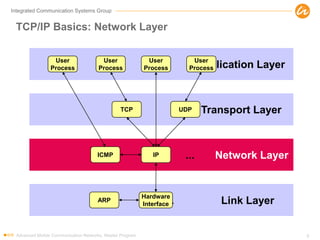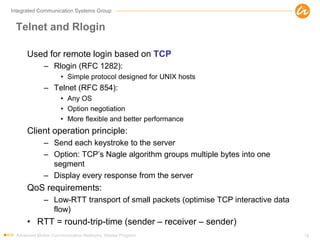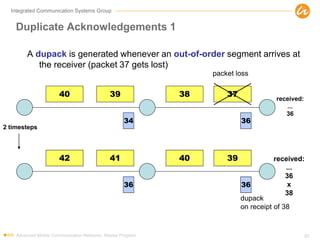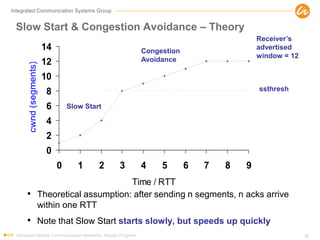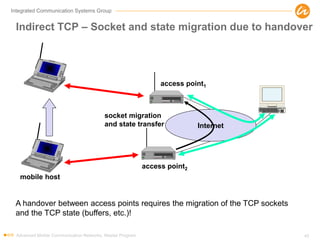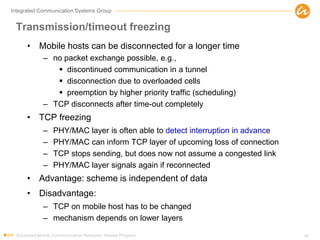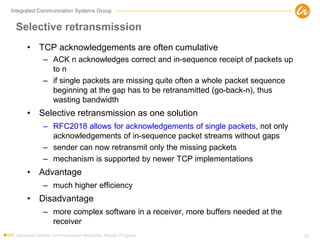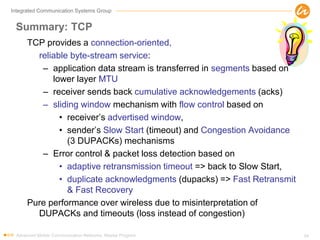TCP-IP NETWORKING FOR WIRELESS SYSTEMS
- 1. Integrated Communication Systems Group Ilmenau University of Technology TCP/IP Networking for Wireless Systems
- 2. Integrated Communication Systems Group Content • Internet Protocol Suite – Link Layer: Ethernet, PPP, ARP, MAC Addressing – Network Layer: IP, ICMP, Routing – Transport Layer: TCP, UDP, Port Numbers, Sockets – Application Layer: FTP, Telnet & Rlogin, HTTP, RTP • TCP – Basic Properties – TCP Datagram Format – Connection Setup and Release – MTU and MSS – Cumulative, Delayed and Duplicate Acknowledgements – Sliding Window Mechanism – Flow and Error Control Advanced Mobile Communication Networks, Master Program 2
- 3. Integrated Communication Systems Group Internet Protocol Suite TCP/IP = the “Internet protocol suite“ = a family of protocols for the “Internet” Internet guesstimates 2003: – 800 million users (x 2 each two years), 200 million permanent hosts Standardisation: – ISOC: Internet Society – IAB: Internet Architecture Board • IETF: Internet Engineering Task Force: http://www.ietf.org – Standards & other informations are published as RFCs: Requests for Comments • IRTF: Internet Research Task Force Advanced Mobile Communication Networks, Master Program 3
- 4. Integrated Communication Systems Group Internet Protocol Suite Implementations: – De-facto standard: BSD 4.x implementations (Berkeley Software Distribution) – Subsequent versions come with new TCP features, e.g. 4.3 BSD Tahoe (1988): slow start, congestion avoidance, fast retransmit 4.3 BSD Reno (1990): fast recovery – Other TCP/IP stacks derived from BSD – Implemented mechanisms, default parameter settings, and bugs are different on different operating systems (e.g. versions of MS Windows)! Advanced Mobile Communication Networks, Master Program 4
- 5. Integrated Communication Systems Group TCP/IP Layer Overview Advanced Mobile Communication Networks, Master Program 5 TCP/IP Layers (OSI model*) Tasks Protocol Examples Application (7) Application specific Telnet, rlogin, FTP, SMTP, SNMP, HTTP, ... Transport (4) End-to-end flow of data between application processes TCP, UDP Network (3) Routing of packets between hosts IP, ICMP Link (2) Hardware interface Packet transfer be- tween network nodes PPP, Ethernet, IEEE 802.x, ARP * Mapping between TCP/IP and OSI layers is not always exact.
- 6. Integrated Communication Systems Group TCP/IP Encapsulation Advanced Mobile Communication Networks, Master Program 6 user data user data appl. header Application eth header IP header application data TCP header eth trailer Ethernet Driver 14 20 20 4 Ethernet frame Ethernet: 46...1500 bytes application data TCP header TCP TCP segment 20 IP header application data TCP header IP IP datagram 20...65536 bytes 20 Example: Application data transfer using TCP
- 7. Integrated Communication Systems Group TCP/IP Basics: Link Layer Advanced Mobile Communication Networks, Master Program 7 Application Layer Transport Layer ... Network Layer ... Link Layer User Process User Process User Process User Process TCP UDP IPICMP Hardware Interface ARP
- 8. Integrated Communication Systems Group Link Layer Protocols Examples: – Ethernet (encapsulation of higher layer packets is defined in RFC 894) – PPP: Point-to-Point Protocol for serial lines (RFCs 1332, 1548) MTU: Maximum Transfer Unit (or Max. Transmission Unit) – Maximum IP packet size in bytes (e.g. for Ethernet: 1500, X.25 Frame Relay: 576) Path MTU: – Smallest MTU of any data link in the path between two hosts – Used to avoid IP fragmentation – TCP option: path MTU discovery (RFC 1191) Loopback Interface: – A client application can connect to the corresponding server application on the same host by using the loopback IP address “localhost“ = 127.0.0.1 – Implemented at the link layer, i.e. full processing of transport and IP layers ARP: Address Resolution Protocol (RFC 826) – Address resolution from 32-bit IP addresses to hardware addresses (e.g. 48- bit) Advanced Mobile Communication Networks, Master Program 8
- 9. Integrated Communication Systems Group TCP/IP Basics: Network Layer Advanced Mobile Communication Networks, Master Program 9 Application Layer Transport Layer ... Network Layer ... Link Layer User Process User Process User Process User Process TCP UDP IPICMP Hardware Interface ARP
- 10. Integrated Communication Systems Group IP: Internet Protocol IP provides forwarding between hosts: – Based on 32-bit IP addresses * – Hop-by-hop using routing tables Unreliable, connectionless datagram delivery service: – packet loss, out-of-order delivery, duplication IP fragmentation: used on any link with MTU < original datagram length: – Duplicates IP header for each fragment and sets flags for re- assembly – Re-assembly at the receiving host only, never in the network RFC 791 Applications use the Domain Name Service (DNS) to convert hostnames (e.g. “www.lucent.com“) into IP addresses (135.112.22.95) and vice-versa * IPv6 uses 128-bit addresses Advanced Mobile Communication Networks, Master Program 10
- 11. Integrated Communication Systems Group IP Datagram Format Advanced Mobile Communication Networks, Master Program 11 QoS requirements; rarely used and supported 4-bit version 8-bit type of service 16-bit identification data 20 bytes 4-bit header length 16-bit total length (in bytes) 3-bit flags 13-bit fragment offset 8-bit time to live 8-bit protocol 16-bit IP header checksum 32-bit source IP address 32-bit destination IP address options (if any) IP datagram length in bytes (limit = 65536) - (reserved) - don‘t fragment - more fragments Unique identifier (counter) Limit on the number of routers (countdown) Higher layer identifier, e.g.: ICMP=1 TCP=6 UDP=17 “Real“ frag ment offset / 8IPv4 Number of 32-bit words 16-bit one‘s complement sum of the IP header only checksum error => discard datagram & try to send ICMP message
- 12. Integrated Communication Systems Group ICMP: Internet Control Message Protocol ICMP packet consists of IP header + ICMP message Used for queries and to communicate error messages back to the sender, e.g.: – “Bad IP header“ – “echo request“ (or reply) – “host unreachable“ – Mobile IP messages Messages are used by higher layers, e.g.: – ping, traceroute, TCP, ... HTTP RFC 792 Advanced Mobile Communication Networks, Master Program 12
- 13. Integrated Communication Systems Group TCP/IP Basics: Transport Layer Advanced Mobile Communication Networks, Master Program 13 Application Layer Transport Layer ... Network Layer ... Link Layer User Process User Process User Process User Process TCP UDP IPICMP Hardware Interface ARP
- 14. Integrated Communication Systems Group UDP vs. TCP UDP: User Datagram Protocol (RFC 768) – Simple, unreliable, datagram-oriented transport of application data blocks TCP: Transmission Control Protocol (RFC 793 + others) – Connection-oriented, reliable byte stream service – Details: see section on TCP Port numbers are used for application multiplexing: – Unique address = IP address + port number = “socket“ – Concept of well-known ports, e.g. TCP port 21 for FTP (RFC 1340) Popular API for TCP and UDP connections: Socket API – “Stream sockets“ use TCP – “Datagram sockets“ use UDP Advanced Mobile Communication Networks, Master Program 14
- 15. Integrated Communication Systems Group UDP Datagram Format Advanced Mobile Communication Networks, Master Program 15 16-bit source port number 16-bit destination port number 16-bit UDP length 16-bit UDP checksum data (if any) 8 bytes Optional 16-bit one‘s complement sum of UDP pseudo-header (12 bytes of the IP header) + UDP header + data (padded to 16-bit multiple) checksum error => discard datagram silently UDP datagram length in bytes (redundant) Used for application multiplexing Used for application multiplexing
- 16. Integrated Communication Systems Group TCP/IP Basics: Selected Applications Advanced Mobile Communication Networks, Master Program 16 Application Layer Transport Layer ... Network Layer ... Link Layer User Process User Process User Process User Process TCP UDP IPICMP Hardware Interface ARP
- 17. Integrated Communication Systems Group FTP: File Transfer Protocol File transfer based on TCP TCP control connection: – To well-known server port 21 – ASCII commands TCP data connection QoS requirements: – High throughput (optimise TCP bulk data flow) RFC 959 Advanced Mobile Communication Networks, Master Program 17
- 18. Integrated Communication Systems Group Telnet and Rlogin Used for remote login based on TCP – Rlogin (RFC 1282): • Simple protocol designed for UNIX hosts – Telnet (RFC 854): • Any OS • Option negotiation • More flexible and better performance Client operation principle: – Send each keystroke to the server – Option: TCP’s Nagle algorithm groups multiple bytes into one segment – Display every response from the server QoS requirements: – Low-RTT transport of small packets (optimise TCP interactive data flow) • RTT = round-trip-time (sender – receiver – sender) Advanced Mobile Communication Networks, Master Program 18
- 19. Integrated Communication Systems Group HTTP: Hypertext Transfer Protocol Transfer of webpages based on TCP: – Webpage typically consists of an HTML (Hyper Text Markup Language) document + various embedded objects, e.g. pictures HTTP/1.0: – Objects are (requested and received) serially – For each object, a new TCP connection is established, used and released – Multiple connections: several TCP connections can be used in parallel Advanced Mobile Communication Networks, Master Program 19
- 20. Integrated Communication Systems Group HTTP: Hypertext Transfer Protocol HTTP/1.1 (RFC 2068): performance improvements by – Persistent Connections: • TCP connections are not released after each object, but used for the next one – avoids TCP connection establishment and termination – avoids slow start for each new connection – Pipelining: • Multiple objects can be requested in one packet • Requested objects are sent sequentially over one TCP connection HTTP/2 (RFC 7540): decreased latency due to – Parallel loading of page elements over single TCP connection – header compression – Server initiated data transmission (push technology) Advanced Mobile Communication Networks, Master Program 20
- 21. Integrated Communication Systems Group RTP: Real-time Transport Protocol Transfer of real-time data based on UDP RTP: – for media with real-time characteristics (audio/video) – services: payload type specification, sequence numbering, timestamping, source identification & synchronization, delivery monitoring – no guaranteed quality of service (QoS) RTCP (Real-time Transport Control Protocol): – QoS monitoring & periodic feedback: • Sender report (synchronisation, expected rates, distance) • Receiver report (loss ratios, jitter) Network independent: on top of unreliable, low-delay transport service RFC 1889 ITU-T H.225.0 Annex A => H.323 => e.g. MS Netmeeting, VoIP Advanced Mobile Communication Networks, Master Program 21
- 22. Integrated Communication Systems Group Summary: Internet Protocol Suite The TCP/IP protocol suite is a heterogenous family of protocols for the global Internet At the center and always used: IP – Routing between hosts Application data transport by – UDP: unreliable datagram service – TCP: reliable byte-stream service TCP/IP stack is part of each operating system: – Numerous different implementations and bugs exist TCP performance is extremely important! – TCP carries 62% of the flows, 85% of the packets, and 96% of the bytes of Internet traffic (http://www.cs.columbia.edu/~hgs/internet/traffic.html) – TCP’s complex error control mechanisms are designed for wired networks => special problems for wireless transport Advanced Mobile Communication Networks, Master Program 22
- 23. Integrated Communication Systems Group TCP (Transmission Control Protocol) Properties Connection-oriented, reliable byte-stream service: – Reliability by ARQ (Automatic Repeat reQuest): • TCP receiver sends acknowledgements (acks) back to TCP sender to confirm delivery of received data • Cumulative, positive acks for all contiguously received data • Timeout-based retransmission of segments – TCP transfers a byte stream: • Segmentation into TCP segments, based on MTU • Header contains byte sequence numbers Congestion avoidance + flow control mechanism In the following examples: – Packet sequence numbers (instead of byte sequence numbers) – ack i acknowledges receipt of packets through packet i (instead of bytes) Advanced Mobile Communication Networks, Master Program 23
- 24. Integrated Communication Systems Group TCP Segment Format Advanced Mobile Communication Networks, Master Program 24 6 bits reserved 16-bit source port number data (if any) 20 bytes 4-bit header length 16-bit window size 16-bit TCP checksum 32-bit sequence number options (if any) 16-bit destination port number 32-bit acknowledgment number 6-bit flags 16-bit urgent pointer 16-bit one‘s complement sum of TCP pseudo-header (12 bytes of the IP header) + TCP header + data (padded to 16-bit multiple) checksum error => discard datagram silently! => using an erroneous header is dangerous; loss will be detected by other mechanismsUrgent Pointer (2 Byte): Identifies the number of the first data byte in this segment within the byte stream Ack for the reverse link: next sequence number that is expected to be received Number of 32- bit words Advertised window size: number of bytes the receiver is willing to accept URG: Urgent Pointer field significant - urgent data are outstanding ACK: Acknowledgment field significant PSH: Push Function - push to indicate prompt transmission of data RST: Reset the connection SYN: Synchronize sequence numbers FIN: No more data from sender TCP is full duplex: Each segment contains an ack for the reverse link A ”pure” ack is a segment with empty data
- 25. Integrated Communication Systems Group TCP Connection Establishment and Termination Advanced Mobile Communication Networks, Master Program 25 Client Server Segment 3: ACK Three-way handshake *ISN: initial sequence number (RFC 793) Segment 1: SYN + ISN* + options, e.g. MSS Active open: Segment 2: SYN, ACK + ISN + options, e.g. MSS Passive open: Application close => Segment 1: FIN Active close: Passive close: => Send EOF to application Segment 2: ACK; application can still send data Half-close #1 Application close => Segment 3: FIN Segment 4: ACK Half-close #2 => Connection establishment & termination take at least 1 RTT
- 26. Integrated Communication Systems Group MTU and MSS: Maximum Segment Size Advanced Mobile Communication Networks, Master Program 26 Client Server Application TCP IP Link Layer Request to connect to Server SYN, MSS=536 TCP Connection establishment MSS = 536 - Fixed TCP header = 20 - Fixed IP header = 20 MTU = 576 (e.g. modem) MSS = 1460 - Fixed TCP header = 20 - Fixed IP header = 20 MTU = 1500 (e.g. ethernet) SYN, ACK, MSS=1460 find network interface MSS is optionally announced (not negotiated) by each host at TCP connection establishment. The smaller value is used by both ends, i.e. 536 in the above example. Note that “real“ TCP payload is smaller if TCP options are used.
- 27. Integrated Communication Systems Group Cumulative Acknowledgements A new cumulative ack is generated only on receipt of a new in- sequence segment Advanced Mobile Communication Networks, Master Program 27 i data acki TCP sender TCP receiverRouter40 39 3738 received: ... 35 36 41 40 3839 35 373634 received: ... 35 36 37 timestep 3533 3634
- 28. Integrated Communication Systems Group Delayed Acknowledgements Delaying acks reduces ack traffic An ack is delayed until – another segment is received, or – delayed ack timer expires (200 ms typical) Advanced Mobile Communication Networks, Master Program 28 40 39 3738 3533 received: ... 35 36 New ack not produced on receipt of segment 36, but on receipt of 37 41 40 3839 35 37 received: ... 35 36 37
- 29. Integrated Communication Systems Group Duplicate Acknowledgements 1 A dupack is generated whenever an out-of-order segment arrives at the receiver (packet 37 gets lost) Advanced Mobile Communication Networks, Master Program 29 40 39 3738 3634 received: ... 36 42 41 3940 36 36 received: ... 36 x 38 dupack on receipt of 38 2 timesteps packet loss
- 30. Integrated Communication Systems Group Duplicate Acknowledgements 2 Dupacks are not delayed Dupacks may be generated when – a segment is lost (see previous slide), or – a segment is delivered out-of-order: Advanced Mobile Communication Networks, Master Program 30 40 39 3837 3634 41 40 3739 36 36 dupack on receipt of 38 received: ... 36 x 38 received: ... 36 1 timestep
- 31. Integrated Communication Systems Group Duplicate Acknowledgements 3 Advanced Mobile Communication Networks, Master Program 31 40 37 3839 3634 41 40 3937 36 36 dupack 34 received: ... 36 x 38 received: ... 36 42 41 3740 36 36 36 dupackdupack received: ... 36 x 38 39 43 42 4041 36 36 39 new ackdupack received: ... 36 37 38 39 36 dupack Number of dupacks depends on how much out-of-order a packet is A series of dupacks allows the sender to guess that a single packet has been lost
- 32. Integrated Communication Systems Group Window Based Flow Control 1 Sliding window protocol Window size W is minimum of – receiver’s advertised window - determined by available buffer space at the receiver and signaled with each ack – congestion window - determined by the sender, based on received acks TCP’s window based flow control is “self-clocking”: – New segments are sent when outstanding segments are ack’d Advanced Mobile Communication Networks, Master Program 32 2 3 4 5 6 7 8 9 10 11 131 12 Sender’s window Acks received Not transmitted
- 33. Integrated Communication Systems Group Window Based Flow Control 2 Optimum window size: – W = data rate * RTT = “bandwidth-delay product” (optimum use of link capacity: “pipe is full”) Advanced Mobile Communication Networks, Master Program 33 What if window size is too large? Queuing at intermediate routers (e.g. at wireless access point) => increased RTT due to queuing delays => potential of packet loss What if window size is too small? Inefficiency: unused link capacity 38 37 3940 33 35 34 36 TCP sender TCP receiverRouter W = 8 segments (33...40) packet dimensions: rate transmit time size
- 34. Integrated Communication Systems Group Packet Loss Detection Based on Timeout TCP sender starts a timer for a segment (only one segment at a time) If ack for the timed segment is not received before timer expires, outstanding data are assumed to be lost and retransmitted => go-back-N ARQ Retransmission timeout (RTO) is calculated dynamically based on measured RTT: – RTO = mean RTT + 4 * mean deviation of RTT • Mean deviation δ = average of |sample – mean| is easier to calculate than standard deviation (and larger, i.e. more conservative) – Large variations in the RTT increase the deviation, leading to larger RTO – RTT is measured as a discrete variable, in multiples of a “tick”: • 1 tick = 500 ms in many implementations • smaller tick sizes in more recent implementations – RTO is at least 2 clock ticks Advanced Mobile Communication Networks, Master Program 34
- 35. Integrated Communication Systems Group Exponential Backoff Double RTO on successive timeouts: Total time until TCP gives up is up to 9 min Rationale: allow an intermediate, congested router to recover Problem: if ack is lost, TCP (sender) just waits for the next timeout Advanced Mobile Communication Networks, Master Program 35 Segment transmitted Timeout occurs before ack received, segment retransmitted Timeout interval doubled T1=RTO T2 = 2 * T1
- 36. Integrated Communication Systems Group Packet Loss Detection Based on Dupacks: Fast Retransmit Mechanism TCP sender considers timeout as a strong indication that there is a severe link problem On the other hand, continuous reception of dupacks indicates that following segments are delivered, and the link is ok => TCP sender assumes that a (single) packet loss has occurred if it receives three dupacks consecutively => Only the (single) missing segment is retransmitted => selective-repeat ARQ Note: 3 dupacks are also generated if a segment is delivered at least 3 places out-of-order => Fast retransmit useful only if lower layers deliver packets “almost ordered” - otherwise, unnecessary fast retransmit Advanced Mobile Communication Networks, Master Program 36
- 37. Integrated Communication Systems Group Flow Control by the Sender Advanced Mobile Communication Networks, Master Program 37 Slow Start Initially, congestion window size (cwnd) = 1 MSS Increment cwnd by 1 MSS on each new ack Slow start phase ends when cwnd reaches ssthresh (slow-start threshold) => cwnd grows exponentially with time during slow start (in theory) – Factor of 1.5 per RTT if every other segment is ack’d – Factor of 2 per RTT if every segment is ack’d – In practice: increase is slower because of network delays (see next slide) Congestion Avoidance On each new ack, increase cwnd by 1/cwnd segments => cwnd grows linearly with time during congestion avoidance (in theory) – 1/2 MSS per RTT if every other segment ack’d – 1 MSS per RTT if every segment ack’d
- 38. Integrated Communication Systems Group Slow Start & Congestion Avoidance – Theory • Theoretical assumption: after sending n segments, n acks arrive within one RTT • Note that Slow Start starts slowly, but speeds up quickly Advanced Mobile Communication Networks, Master Program 38 0 2 4 6 8 10 12 14 0 1 2 3 4 5 6 7 8 9 Time / RTT cwnd(segments) Slow Start Congestion Avoidance ssthresh Receiver’s advertised window = 12
- 39. Integrated Communication Systems Group Slow Start – Reality (Including Network Delay) • Taking network delay into account, “cwnd increases exponentially” turns into: – cwnd increases sub-exponentially – pairs of segments are sent while pipe fills • Simple example: – one-way delay = 1 timestep – data rate = 1 segment/timestep Advanced Mobile Communication Networks, Master Program 39 sending rate > data rate (cwnd > 2) (timestep 4 onwards) => at some point in time there will be a packet loss, causing TCP to slow down Time- step Sender action cwnd #segments sent #segments outstanding #segments recv'd and ack'd Receiver action 0 initial values 1 0 send segment 1 1 1 1 1 receive and ack segment 1 2 receive ack 1 2 0 send segments 2 and 3 2 2 3 1 receive and ack segment 2 4 receive ack 2 3 1 1 receive and ack segment 3 send segments 4 and 5 2 3 5 receive ack 3 4 2 1 receive and ack segment 4 send segments 6 and 7 2 4 6 receive ack 4 5 3 1 receive and ack segment 5 send segments 8 and 9 2 5
- 40. Integrated Communication Systems Group Congestion Control after Packet Loss Packet loss detected by timeout (=> severe link problem): Retransmit lost segments Go back to Slow Start: – Reduce cwnd to initial value of 1 MSS – Set ssthresh to half of window size before packet loss: • ssthresh = max((min(cwnd, receiver’s advertised window)/2), 2 MSS) Packet loss detected by ≥3 dupacks (=> single packet loss, but link is ok): Fast Retransmit single missing segment Initiate Fast Recovery: – Set ssthresh and cwnd to half of window size before packet loss: • ssthresh = max((min(cwnd, receiver’s advertised window)/2), 2 MSS) • cwnd = ssthresh + number of dupacks – When a new ack arrives: continue with Congestion Avoidance: • cwnd = ssthresh Advanced Mobile Communication Networks, Master Program 40
- 41. Integrated Communication Systems Group Packet Loss Detected by Timeout Advanced Mobile Communication Networks, Master Program 41 0 5 10 15 20 250 3 6 9 12 15 20 22 25 Time / RTT cwnd(segments) ssthresh = 8 ssthresh = 10 cwnd = 20 Timeout cwnd = 1
- 42. Integrated Communication Systems Group Packet Loss Detected by ≥3 Dupacks • After fast retransmit and fast recovery window size is reduced in half • Multiple packet losses within one RTT can result in timeout Advanced Mobile Communication Networks, Master Program 42 0 2 4 6 8 10 0 2 4 6 10 12 14 Time / RTT cwnd(segments) After Fast Recovery ssthresh = 4 ≥3 Dupacks cwnd = 8 cwnd = 4
- 43. Integrated Communication Systems Group Influence of wireless transmission on TCP • TCP assumes congestion if packets are dropped – typically wrong in wireless networks, here we often have packet loss due to transmission errors – furthermore, mobility itself can cause packet loss, if e.g. a mobile node roams from one access point (e.g. foreign agent in Mobile IP) to another while there are still packets in transit to the wrong access point and forwarding is not possible • The performance of an unchanged TCP degrades severely – however, TCP cannot be changed fundamentally due to the large base of installations in the fixed network, TCP for mobility has to remain compatible – TCP on server does not know whether peers are mobile or not – the basic TCP mechanisms keep the whole Internet together Advanced Mobile Communication Networks, Master Program 43
- 44. Integrated Communication Systems Group Indirect TCP – Principle • Indirect TCP (I-TCP) segments the connection – no changes to the TCP protocol for hosts connected to the wired Internet, millions of computers use (variants of) this protocol – optimized TCP protocol for mobile hosts – splitting of the TCP connection at, e.g., the foreign agent into 2 TCP connections, no real end-to-end connection any longer – hosts in the fixed part of the net do not notice the characteristics of the wireless part Advanced Mobile Communication Networks, Master Program 44 mobile host access point (foreign agent) „wired“ Internet „wireless“ TCP standard TCP
- 45. Integrated Communication Systems Group Indirect TCP – Socket and state migration due to handover Advanced Mobile Communication Networks, Master Program 45 mobile host access point2 Internet access point1 socket migration and state transfer A handover between access points requires the migration of the TCP sockets and the TCP state (buffers, etc.)!
- 46. Integrated Communication Systems Group Indirect TCP – Discussion • Advantages – no changes in the fixed network necessary, no changes for the hosts (TCP protocol) necessary, all current optimizations to TCP still work – transmission errors on the wireless link do not propagate into the fixed network – simple to control, mobile TCP is used only for one hop between, e.g., a foreign agent and mobile host – therefore, a very fast retransmission of packets is possible, the short delay on the mobile hop is known • Disadvantages – loss of end-to-end semantics, an acknowledgement to a sender does now not any longer mean that a receiver really got a packet, e.g. wireless link may drop or foreign agent might crash – higher latency possible due to buffering of data within the foreign agent and forwarding to a new foreign agent – access point needs to be involved in security mechanisms (e.g. IPsec) Advanced Mobile Communication Networks, Master Program 46
- 47. Integrated Communication Systems Group Snooping TCP – Principle • „Transparent“ extension of TCP within the foreign agent – buffering of packets sent to the mobile host – lost packets on the wireless link (both directions!) will be retransmitted immediately by the mobile host or foreign agent, respectively (so called “local” retransmission) – the foreign agent therefore “snoops” the packet flow and recognizes acknowledgements in both directions, it also filters ACKs – changes of TCP only within the foreign agent Advanced Mobile Communication Networks, Master Program 47 „wired“ Internet buffering of data end-to-end TCP connection local retransmission correspondent hostforeign agent mobile host snooping of ACKs
- 48. Integrated Communication Systems Group Snooping TCP • Data transfer to the mobile host (downlink) – FA buffers data until it receives ACK from the MH – FA detects packet loss on wireless link via timeouts (smaller timeout value than on CN) or DUPACKs from CN (which are discarded) – FA employs fast retransmission, transparent for the fixed network • Data transfer from the mobile host (uplink) – FA detects packet loss on the wireless link via sequence numbers, FA answers directly with a NACK to the MH – MH can now retransmit data with only a very short delay • Integration of the link layer – link layer often has similar mechanisms to those of TCP • Problems – snooping TCP does not isolate the wireless link as good as I-TCP – snooping might be useless depending on encryption schemes, e.g. does not work with IPsec due to encryption of IP payload (including TCP segment number) Advanced Mobile Communication Networks, Master Program 48
- 49. Integrated Communication Systems Group Mobile TCP • Special handling of lengthy and/or frequent disconnections • M-TCP splits control as I-TCP does – unmodified TCP fixed network to supervisory host (SH) – optimized TCP between SH and MH (no slow start) • Supervisory host (SH) – no caching, no retransmission (different from Indirect-TCP) – monitors all packets, if disconnection detected • set sender window size to 0 • sender automatically goes into persistent mode – old or new SH reopens the window (set to old size) • Advantages – maintains semantics, supports disconnection, no buffer forwarding • Disadvantages – loss on wireless link propagated into fixed network (no buffering) – adapted TCP on wireless link Advanced Mobile Communication Networks, Master Program 49
- 50. Integrated Communication Systems Group Transmission/timeout freezing • Mobile hosts can be disconnected for a longer time – no packet exchange possible, e.g., discontinued communication in a tunnel disconnection due to overloaded cells preemption by higher priority traffic (scheduling) – TCP disconnects after time-out completely • TCP freezing – PHY/MAC layer is often able to detect interruption in advance – PHY/MAC can inform TCP layer of upcoming loss of connection – TCP stops sending, but does now not assume a congested link – PHY/MAC layer signals again if reconnected • Advantage: scheme is independent of data • Disadvantage: – TCP on mobile host has to be changed – mechanism depends on lower layers Advanced Mobile Communication Networks, Master Program 50
- 51. Integrated Communication Systems Group Forced fast retransmit/fast recovery • Change of foreign agent often results in packet loss – TCP reacts with slow-start although there is no congestion • Forced fast retransmit – as soon as the mobile host has registered with a new foreign agent (Mobile IP), the MH sends DUPACKs on purpose – this forces the fast retransmit mode at the communication partners (instead of slow start) – additionally, the TCP on the MH is forced to continue sending with the actual window size and not to go into slow-start after registration • Advantage – simple changes result in significant higher performance • Disadvantage – focus on problems due to (fast) handover, not on temporarily poor wireless link quality – mix of Mobile IP and TCP, no transparent approach Advanced Mobile Communication Networks, Master Program 51
- 52. Integrated Communication Systems Group Selective retransmission • TCP acknowledgements are often cumulative – ACK n acknowledges correct and in-sequence receipt of packets up to n – if single packets are missing quite often a whole packet sequence beginning at the gap has to be retransmitted (go-back-n), thus wasting bandwidth • Selective retransmission as one solution – RFC2018 allows for acknowledgements of single packets, not only acknowledgements of in-sequence packet streams without gaps – sender can now retransmit only the missing packets – mechanism is supported by newer TCP implementations • Advantage – much higher efficiency • Disadvantage – more complex software in a receiver, more buffers needed at the receiver Advanced Mobile Communication Networks, Master Program 52
- 53. Integrated Communication Systems Group Comparison of different approaches for a “mobile” TCP Advanced Mobile Communication Networks, Master Program 53
- 54. Integrated Communication Systems Group Summary: TCP TCP provides a connection-oriented, reliable byte-stream service: – application data stream is transferred in segments based on lower layer MTU – receiver sends back cumulative acknowledgements (acks) – sliding window mechanism with flow control based on • receiver’s advertised window, • sender’s Slow Start (timeout) and Congestion Avoidance (3 DUPACKs) mechanisms – Error control & packet loss detection based on • adaptive retransmission timeout => back to Slow Start, • duplicate acknowledgments (dupacks) => Fast Retransmit & Fast Recovery Pure performance over wireless due to misinterpretation of DUPACKs and timeouts (loss instead of congestion) Advanced Mobile Communication Networks, Master Program 54
- 55. Integrated Communication Systems Group References • Jochen Schiller: Mobile Communications (German and English), Addison-Wesley, 2005 (chapter 9 provides an overview on different approaches) • Ramjee Prasad, Marina Ruggieri: Technology Trends in Wireless Communications, Artech House, 2003 • The bible: W. Richard Stevens, “TCP/IP Illustrated, Volume 1: The Protocols“ • Douglas E. Comer: Computernetzwerke und Internets. 3. Auflage, Pearson Studium, Prentice Hall, 2002 • Standards (RFCs): http://www.ietf.org/ • Selected papers on TCP over wireless: – Balakrishnan et al, “A comparison of mechanisms for improving TCP performance over wireless links”, IEEE/ACM Transactions on Networking, Dec. 1997 – Xylomenos et al, “TCP performance issues over wireless links”, IEEE Communications Magazine, April 2001 – Balakrishnan et al, “How network asymmetry affects TCP”, IEEE Communications Magazine, April 2001 Advanced Mobile Communication Networks, Master Program 55








